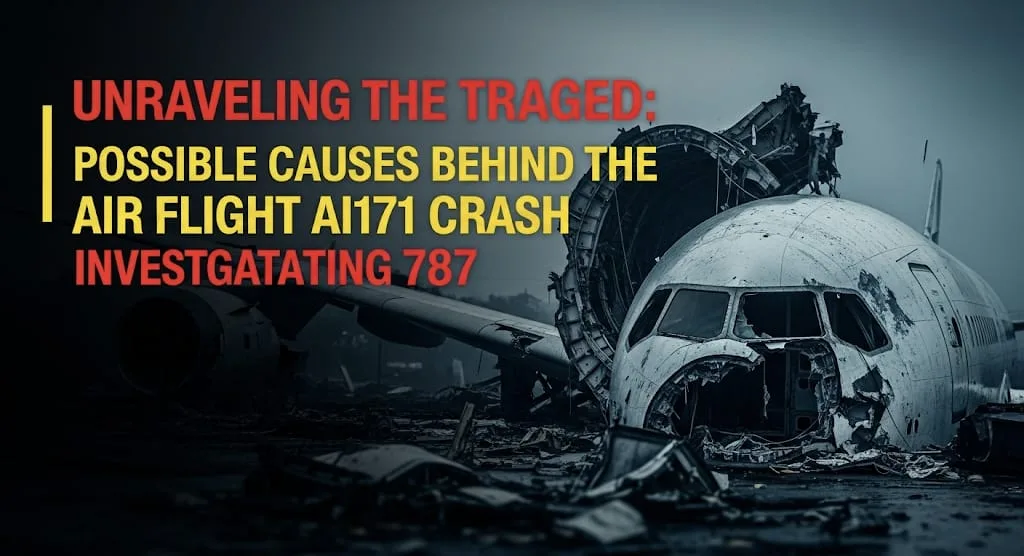The catastrophic crash of Air India Flight AI171, a Boeing 787-8 Dreamliner (registration VT-ANB), on June 12, 2025, shortly after takeoff from Ahmedabad’s Sardar Vallabhbhai Patel International Airport, has left investigators with a complex puzzle. With 241 lives lost onboard and at least 38 on the ground, this incident marks the first fatal hull loss of a Boeing 787 Dreamliner, demanding a meticulous and transparent investigation by India’s Aircraft Accident Investigation Bureau (AAIB), with support from international agencies and Boeing itself. While the official findings are awaited, initial reports and expert analyses point to several possible causes that will undoubtedly be scrutinized.
The flight crew’s mayday call, reporting a “loss of power and thrust” just seconds after liftoff, is a critical piece of evidence. The aircraft was airborne for a mere 30 seconds, reaching a maximum altitude of approximately 625 feet before rapidly descending and impacting a residential area. This sudden and catastrophic failure, occurring in the critical phase of flight, points towards immediate and severe technical or operational issues.
Dual Engine Failure or Loss of Thrust ⚙️
The most immediate and concerning possibility, strongly suggested by the pilot’s distress call and the rapid loss of altitude, is a failure of both engines or a simultaneous loss of thrust from both powerplants.
- Ram Air Turbine (RAT) Deployment: Initial investigative findings, as reported by The Wall Street Journal, indicate that the aircraft’s Ram Air Turbine (RAT) was operating when the airliner crashed. The RAT is a small propeller-driven turbine that automatically deploys from the fuselage to generate emergency electrical and hydraulic power in critical situations, particularly a loss of engine power or complete electrical failure. This suggests that the aircraft’s primary power systems were compromised almost immediately after takeoff.
- “No Thrust” Call: The pilot’s clear transmission of “no thrust” implies that even if the engines were physically running, they were not producing the necessary power to sustain flight. This could stem from:
- Fuel starvation or contamination: Issues with fuel delivery to the engines or contamination of the fuel itself.
- Engine control system malfunction: Problems with the Electronic Engine Control (EEC) system, which manages engine parameters.
- Catastrophic internal engine failure: While extremely rare for modern, highly reliable engines like the General Electric GEnx-1B67s on VT-ANB, a simultaneous or cascading failure cannot be immediately ruled out.
- External factors: Though less likely given the immediate post-takeoff scenario, severe bird strikes affecting both engines, while rare, could lead to such a rapid power loss.
Air India has stated that the aircraft’s right engine was overhauled in March 2025 and the left engine had its last inspection in April 2025, with both having “clean histories.” Investigators will meticulously examine these maintenance records and the recovered engine components.
Critical Flight Control or Hydraulic System Failure 🚨
Another potential cause could be a sudden and catastrophic failure of the flight control systems or the hydraulic systems that power them. The Boeing 787 is a “fly-by-wire” aircraft, meaning control inputs are transmitted electronically, relying heavily on hydraulic and electrical power.
- Loss of Control Surfaces: A major hydraulic failure could render the aircraft’s control surfaces (flaps, slats, elevators, rudder, ailerons) unresponsive or partially functional. The Wall Street Journal also reported that initial findings indicated the flaps and other control surfaces were properly configured for takeoff, but a subsequent failure could have occurred.
- Actuator Malfunction: Issues with the actuators that move these surfaces could lead to a loss of control.
- Electrical System Failure: Given the integration of electrical systems in the 787, a significant electrical malfunction could cripple multiple critical systems, including flight controls and engine management. The RAT deployment also points to potential electrical issues.
Structural Failure or Manufacturing Defect 🛠️
While less common, especially so early in a flight, a structural failure or a pre-existing manufacturing defect cannot be entirely dismissed, particularly given the recent scrutiny Boeing’s 787 program has faced.
- Whistleblower Concerns: The 787 program has been subject to various whistleblower allegations in recent years concerning quality control issues, including improper fastening of fuselage sections and manufacturing flaws that could compromise structural integrity over time. While Boeing has stated these issues do not pose immediate flight safety concerns for in-service aircraft, the AAIB will investigate if any such latent defect could have contributed.
- Fatigue or Undetected Damage: Though VT-ANB was only 11 years old, a rapid structural failure could potentially stem from undetected fatigue or damage from a previous incident.
Human Factors / Crew Actions 🤔

While often highlighted last, the actions and decisions of the flight crew, or issues related to their operational environment, are always a critical part of any investigation.
- Pilot Incapacitation: While no evidence currently supports this, investigators will check for any signs of pilot incapacitation.
- Crew Resource Management (CRM): The interaction and coordination between the two pilots during the emergency will be analyzed through the Cockpit Voice Recorder (CVR) data.
- Training or Procedures: Any potential deviations from standard operating procedures (SOPs) or gaps in training will be examined. It’s noted that the pilot gave a Mayday call, indicating he was actively responding to the situation.
- Recent Scrutiny on Air India Pilot Duty Norms: The Directorate General of Civil Aviation (DGCA) has recently ordered Air India to remove three officials from crew scheduling responsibilities and issued a show-cause notice regarding violations of flight duty time limitations norms. While this doesn’t directly point to the crash’s cause, it highlights a broader regulatory concern about operational pressures on pilots within the airline.
Key Possible Causes Being Investigated for AI171
| Possible Cause | Key Indicators/Focus Areas |
| Dual Engine Failure / Loss of Thrust | Pilot’s “loss of power and thrust” call, RAT deployment, analysis of engine components and fuel system. |
| Flight Control / Hydraulic Failure | Sudden loss of aircraft control, RAT deployment (indicating power loss to systems), examination of hydraulic lines and actuators. |
| Structural Failure / Manufacturing Defect | Examination of wreckage for pre-existing flaws, consideration of past whistleblower allegations regarding 787 manufacturing. |
| Human Factors / Crew Actions | Analysis of CVR data for crew communication and response, adherence to SOPs, and potential incapacitation. |
The Road to Answers: A Long and Painful Process
The recovery of both the Flight Data Recorder (FDR) and the Cockpit Voice Recorder (CVR) – often referred to as the “black boxes” – is paramount. While initial reports suggest some damage to these units, experts are working to retrieve the crucial data.
This data, combined with a meticulous examination of the wreckage, air traffic control recordings, and the aircraft’s detailed maintenance history, will slowly but surely piece together the complete picture. The investigation, led by the AAIB, is a complex process that could take months, if not over a year, but its findings will be vital in preventing similar tragedies in the future and enhancing the safety of the global aviation industry. The world watches, waiting for answers to this unprecedented Dreamliner disaster.
Frequently Asked Questions (FAQs)
Q1: What was the primary distress call made by the pilots of Air India Flight AI171?
A1: The pilots of Air India Flight AI171 issued a mayday call reporting a “loss of power and thrust” almost immediately after takeoff.
Q2: What is the significance of the Ram Air Turbine (RAT) being activated in the Air India AI171 crash?
A2: The activation of the Ram Air Turbine (RAT) suggests a significant loss of primary electrical and/or hydraulic power from the aircraft’s engines or main systems. The RAT is an emergency system designed to provide backup power in such critical situations.
Q3: Has the Boeing 787 Dreamliner ever had a fatal crash before Air India Flight AI171?
A3: No, the crash of Air India Flight AI171 on June 12, 2025, marks the first fatal crash and first hull loss involving a Boeing 787 Dreamliner since the aircraft type entered commercial service in 2011.












